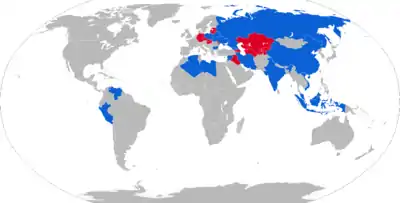Kh-29
The Kh-29 (Russian: Х-29; NATO: AS-14 'Kedge'; GRAU: 9M721) is a Soviet air-to-surface missile with a range of 10–30 km. It has a large warhead of 320 kg, has a choice of laser, infrared, active radar or TV guidance, and is typically carried by tactical aircraft such as the Su-24, Su-30, MiG-29K as well as the "T/TM" models of the Su-25, giving that craft an expanded standoff capability.
| Kh-29 (NATO reporting name: AS-14 'Kedge') | |
|---|---|
 Side-view of Kh-29D. | |
| Type | air-to-surface missile |
| Place of origin | Soviet Union |
| Service history | |
| In service | 1980s-current |
| Used by | Warsaw Pact, China, India, Iraq |
| Wars | Iran–Iraq War Second Libyan Civil War Russian-led military intervention in Syria Syrian Civil War |
| Production history | |
| Designer | Matius Bisnovat Georgiy I. Khokhlov |
| Designed | 1975 |
| Manufacturer | Vympel / Tactical Missiles Corporation[1] |
| Produced | 1980-current[2] |
| Specifications | |
| Mass | Kh-29L :660 kg (1,460 lb) [3] Kh-29T :685 kg (1,510 lb) [3] Kh-29TE :690 kg (1,520 lb) [3] |
| Length | Kh-29L/T :390 cm (12 ft 10 in)[3] Kh-29TE :387.5 cm (12 ft 9 in)[3] |
| Diameter | 38.0 cm (15.0 in) [3] |
| Warhead | HE armour-piercing[1] |
| Warhead weight | 320 kg (705 lb)[1] |
Detonation mechanism | Impact [1] |
| Engine | Fixed thrust solid fuel rocket[1] |
| Wingspan | 110 cm (43 in) [3] |
Operational range | Kh-29L :10 km (5.4 nmi)[3] Kh-29T :12 km (6.5 nmi) [3] Kh-29TE :30 km (16 nmi) [3] |
| Maximum speed | 1,470 km/h (910 mph)[4] Kh-29ML: 900–1,260 km/h (560–780 mph)[5] |
Guidance system | Kh-29L: semi-active laser guidance Kh-29T/TE : passive homing TV guidance Kh-29D : infrared homing guidance (IIR)[6][7] Kh-29MP : active radar homing [8] |
Launch platform | Kh-29L&T: MiG-27K,[3] MiG-29M,[3] Su-27UB,[3] Su-30MK,[3] Su-39[3] Kh-29L only: Su-25[3] |
The Kh-29 is intended for primary use against larger battlefield targets and infrastructure such as industrial buildings, depots and bridges,[10] but can also be used against ships up to 10,000 tonnes, hardened aircraft shelters and concrete runways.[1]
Development
Design started in the late 1970s at the Molniya design bureau in Ukraine on what would be their only air-to-ground munition, but when they moved exclusively to space work Vympel took over development of the Kh-29.[10] The first firing of the missile took place in 1976 and after extensive trials the Kh-29 was accepted into service in 1980.[4]
Design
The basic aerodynamic layout of the Kh-29 is similar to the Molniya R-60 (AA-8 'Aphid'), reflecting Molniya's heritage in air-to-air missiles.[10] The laser guidance head came from the Kh-25 (AS-10 'Karen') and the TV guidance from the Kh-59 (AS-13 'Kingbolt'), mated to a large warhead.[9]
It has been compared to the United States' AGM-65 Maverick, but the AGM-65 is a much smaller missile than the Kh-29, and weighs less than half as much.[10]
Operational history
The Kh-29 entered service with the Soviet Air Force in 1980, and has been widely exported since.
The Kh-29L were used by Sukhoi Su-34 and Su-24 aircraft in the 2015 Russian military intervention in the Syrian Civil War.[11]
2014 Libyan conflict
Libyan Su-24-borne Kh-29Ts supplied in large quantities to Muammar Gaddafi's Jamahiriya have been used by Islamist factions against pro-government forces around Tripoli during the current low-level civil war (they were seized from Ghardabiya Air Base depots). Their use, however, was in an unguided ground-to-ground role, launched from modified trucks and with their fins and ailerons at the front and back removed for a somewhat more stable flight path.
Variants
- Kh-29L (Izdeliye 63, 'Kedge-A')[10] uses semi-active laser seeker and has a range of 8–10 km.[3]
- Kh-29ML is an upgraded version of the Kh-29L.[10]
- Kh-29T (Izdeliye 64, 'Kedge-B')[10] is the TV-guided version which is fitted with automatic optical homing to a distinguishable object indicated by the pilot in the cockpit.
- Kh-29TE[12] is a long-range (30 km) development of the Kh-29T.[3] Minimum range is 3 km; launch altitude is 200-10,000 m.[3]
- Kh-29MP is a third generation guidance variant with active radar homing, making it a fire-and-forget weapon. It has a large 250 kg warhead with 12 km range.[6][8]
- Kh-29D is the fourth variant of the Kh-29TE which uses infrared imaging guidance.[6][7]
Operators

Current operators
 Russia: Russian Air Force
Russia: Russian Air Force India: Indian Air Force on its Su-30MKIs[4] and Indian Navy on its MiG-29Ks.[13]
India: Indian Air Force on its Su-30MKIs[4] and Indian Navy on its MiG-29Ks.[13] Algeria: Algerian Air Force [14]
Algeria: Algerian Air Force [14] Belarus: Belarusian Air Force on its modernized MiG-29BMs.[4]
Belarus: Belarusian Air Force on its modernized MiG-29BMs.[4] Bulgaria: Bulgarian Air Force on its Su-22M4s,[4] which were withdrawn from service in 2004 and now used only for reconnaissance. Currently used on Su-25.
Bulgaria: Bulgarian Air Force on its Su-22M4s,[4] which were withdrawn from service in 2004 and now used only for reconnaissance. Currently used on Su-25. Georgia: Georgian Air Force on its SU-25KM Scorpion [15]
Georgia: Georgian Air Force on its SU-25KM Scorpion [15] Indonesia: TNI-AU = Tentara Nasional Indonesia – Angkatan Udara (Indonesian Air Force) on its Su-30MK2[16]
Indonesia: TNI-AU = Tentara Nasional Indonesia – Angkatan Udara (Indonesian Air Force) on its Su-30MK2[16] Iran: Islamic Republic of Iran Air Force on its Su-24 Fencer
Iran: Islamic Republic of Iran Air Force on its Su-24 Fencer North Korea[17]
North Korea[17] Libya: Islamist militias
Libya: Islamist militias Malaysia: Royal Malaysian Air Force use on its Su-30MKM
Malaysia: Royal Malaysian Air Force use on its Su-30MKM People's Republic of China: People's Liberation Army Air Force – received 2,000 Kh-29Ts in 2002[18] for use on their Su-27SKs, Su-27UBKs, Su-30MKKs, Shenyang J-11s and possibly their JH-7s ('Flounder') and Q-5's ('Fantan').[19]
People's Republic of China: People's Liberation Army Air Force – received 2,000 Kh-29Ts in 2002[18] for use on their Su-27SKs, Su-27UBKs, Su-30MKKs, Shenyang J-11s and possibly their JH-7s ('Flounder') and Q-5's ('Fantan').[19] Poland: Polish Air Force on its on Su-22M4s.[4]
Poland: Polish Air Force on its on Su-22M4s.[4] Syria: Syrian Air Force
Syria: Syrian Air Force Ukraine: Ukrainian Air Force[4]
Ukraine: Ukrainian Air Force[4] Peru: Peruvian Air Force on its Su-25
Peru: Peruvian Air Force on its Su-25 Venezuela: Venezuelan Air Force on its Su-30
Venezuela: Venezuelan Air Force on its Su-30 Vietnam: Vietnam People's Air Force on its Su-30MK2V
Vietnam: Vietnam People's Air Force on its Su-30MK2V Yemen: Yemen Air Force
Yemen: Yemen Air Force
Former operators
 Czechoslovakia: Czechoslovak Air Force – passed onto successor states[4]
Czechoslovakia: Czechoslovak Air Force – passed onto successor states[4] East Germany: East German Air Force[4]
East Germany: East German Air Force[4] Germany: Phased out after the German reunification
Germany: Phased out after the German reunification Hungary: Hungarian Air Force on Su-22M3s
Hungary: Hungarian Air Force on Su-22M3s Iraq: Iraqi Air Force – all retired
Iraq: Iraqi Air Force – all retired.svg.png.webp) Libyan Arab Jamahiriya: Libyan Air Force – Left without launch platforms after Su-24s were destroyed in the civil war and subsequent NATO bombing. Seized by rebels and militias.
Libyan Arab Jamahiriya: Libyan Air Force – Left without launch platforms after Su-24s were destroyed in the civil war and subsequent NATO bombing. Seized by rebels and militias. Slovakia: Slovak Air Force – Su-22M4s[4]
Slovakia: Slovak Air Force – Su-22M4s[4] Soviet Union: Soviet Air Force – passed onto successor states
Soviet Union: Soviet Air Force – passed onto successor states
See also
- Kh-25 (AS-10/12 'Karen/Kegler') – 320 kg missile with 90 kg warhead and 10–25 km range
- AGM-65 Maverick – 200–300 kg missile with 57–135 kg warhead and 27 km range
- AGM-62 Walleye I – 1967 US glide bomb delivering 385 kg warhead over 30 km.
Notes
| Wikimedia Commons has media related to Vympel Kh-29. |
- X-29TE / X-29L, Tactical Missiles Corporation, archived from the original on 28 September 2007, retrieved 6 February 2009
- "ОАО "Корпорация Тактическое Ракетное Вооружение"". Retrieved 23 December 2014.
- Rosoboronexport Air Force Department and Media & PR Service, AEROSPACE SYSTEMS export catalogue (PDF), Rosoboronexport State Corporation, p. 122, archived from the original (PDF) on 30 October 2007
- Fiszer, Michal A. "25 years of service of Russian Kh-29 missile". Situational Awareness. Retrieved 7 September 2008. Written by Polish former Su-22 pilot
- "KH-29". The Probert Encyclopaedia. Archived from the original on 2 June 2008. Retrieved 5 September 2008.
- Friedman, Norman (1997). The Naval Institute Guide to World Naval Weapons Systems, 1997–1998. ISBN 9781557502681. Retrieved 23 December 2014.
- "Kh-29D". deagel.com.
- "Russian Air Force 3.8". Archived from the original on 14 June 2012. Retrieved 23 December 2014.
- "Vympel Kh-29 (AS-14 'Kedge')", Jane's Electro-Optic Systems, 4 September 2008, archived from the original on 26 January 2013, retrieved 6 February 2009
- "Kh-29 (AS-14 'Kedge')", Jane's Air-Launched Weapons, 6 August 2008
- Polina Devitt (4 October 2015). "Russian air force using laser-guided KH-29L missiles in Syria – RIA". Reuters. Retrieved 7 October 2015.
- "Kh-29TE". Rosoboronexport.
- John Pike. "MiG-29K FULCRUM". GlobalSecurity. Retrieved 23 December 2014.
- "Archived copy". Archived from the original on 18 October 2013. Retrieved 17 October 2013.CS1 maint: archived copy as title (link)
- "Fighter SU-25KM (Scorpion)". Retrieved 23 December 2014.
- 2011 Annual Report of Tactical Missile Corporation, "Archived copy". Archived from the original on 21 August 2012. Retrieved 31 July 2013.CS1 maint: archived copy as title (link)
- https://www.businessinsider.com/photo-north-korean-fighter-jet-missile-after-kim-base-visit-2020-4
- Gertz, Bill (1 July 2002), "China test-fires new air-to-air missile; Taiwan likely to get upgraded arms", The Washington Times, p. A1
- Fisher, Richard D., Jr. (January 2004), The Impact Of Foreign Weapons And Technology On The Modernization Of China's People's Liberation Army, US-China Economic and Security Review Commission, pp. 4–2C, archived from the original on 29 April 2007
References
- Gordon, Yefim (2004), Soviet/Russian Aircraft Weapons Since World War Two, Hinckley, England: Midland Publishing, ISBN 1-85780-188-1